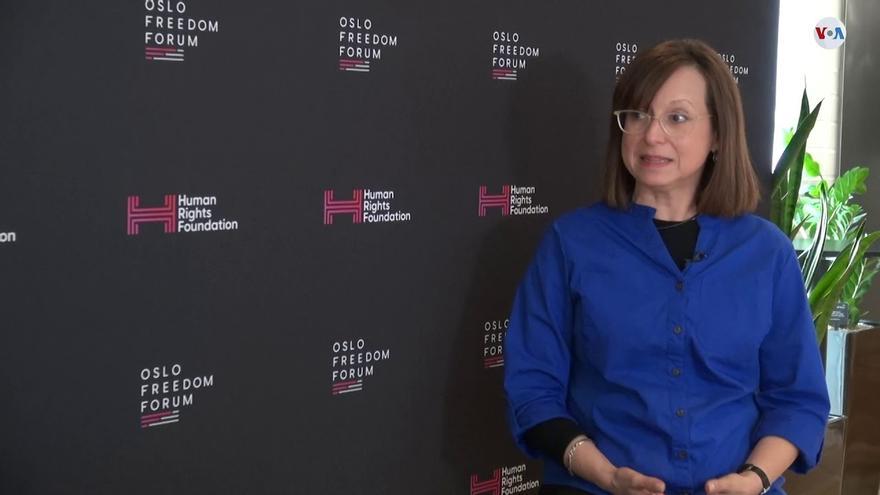
![]() EFE (via 14ymedio), Jorge Ignacio Pérez, Miami, February 26, 2020 — The Cuban-American researcher María Werlau had to fit together the pieces “like a puzzle” for her new book, in which she tackles in a comprehensive manner what she defines as the “asymmetric occupation” of Venezuela by Cuba, which, as she tells Efe, is “worse” than she imagined when she started.
EFE (via 14ymedio), Jorge Ignacio Pérez, Miami, February 26, 2020 — The Cuban-American researcher María Werlau had to fit together the pieces “like a puzzle” for her new book, in which she tackles in a comprehensive manner what she defines as the “asymmetric occupation” of Venezuela by Cuba, which, as she tells Efe, is “worse” than she imagined when she started.
“There are a few books and a lot of journalistic material, so I had to assemble everything. I don’t believe that there have been serious academic works of the kind that it is necessary to bring to this matter,” she said just before presenting this Wednesday in Miami María Werlau calls for end of Cuban dominion over Venezuela.
“There was a lot of loose and scattered material on different angles of the Cuban intervention, but there hadn’t been anything comprehensive on what was happening in Venezuela,” says Werlau, who arrived to the United States as a political refugee at eight months old.
“It was like a puzzle. On the way I realized that it was worse than what I had imagined,” she emphasized. Werlau, who is also an independent consultant, wants to put this material “at the disposal of analysts and governments.”
The volume, with almost 300 pages and 11 chapters, is published by the Free Society Project and is available in English and Spanish, although the additional chapter, The insurrectionary offensive of 2019: a change of tactics already tried, is only available in Spanish.
Cuba’s Intervention in Venezuela: A Strategic Occupation with Global Implications has around 1,600 bibliographic citations, more than 800 sources on the subject, and of those, more than 30 primary sources.
The volume goes back to the time of Venezuela’s constitutional government of Rómulo Betancourt (1959-1964), whom Fidel Castro immediately visited to propose “the same thing that he proposed to (Hugo) Chávez,” the “radical alliance” between the two countries, which remains in place despite the deaths of its architects.
“Fidel arrives in Venezuela (in 1959) 15 days after entering Havana (…). He arrives with the entire top brass of the rebel army and meets with Rómulo Betancourt and proposes to him the same thing he proposed to (Hugo) Chávez,” says the executive director of the NGO Free Society Project, better known as Cuba Archive.
According to Werlau, Castro was obsessed with Venezuela because of its geopolitical situation, as the doorway to the Caribbean, as well as its oil wealth.
The book, which according to the author “could have been the genesis of the Castro-Chávez relationship,” has a much broader content.
“It explains how, although Cuba is much smaller, poorer, and under-developed, it achieved the dominant role with a methodology derived from the totalitarian nature of its system,” as is read in the notes of the presentation.
Among the oral sources that Werlau consulted are retired generals in Venezuela and abroad, as well as experts in computer science.
One of those is Anthony Daquin, specialist in computer security systems, who spoke to Werlau about the fiber optic underwater cable that connects the two countries.
When Werlau says that to eradicate Cuban dominion over Venezuela “it’s necessary to cut the cable and start from zero,” it’s not a metaphor.
“In Cuba they said that (the cable) didn’t work, but I was impressed with what had been achieved,” she says.
“Cuba takes control of all the identity information of Venezuelans, manages communications, social media. The program to monitor this is called Estela [Wake]. Cuba has access to all of the identity of Venezuelans; I won’t even talk to you about the electoral register,” says the author.
“You don’t need a military force or weapons in the street to take a country,” explains Werlau on her concept of “assymetric occupation.”
But the author goes further and goes deep into the “social engineering” employed by Castroism, in the chapter Santeria, a sophisticated invasion. “Cuba had 20 more years to prepare its urban scenes, since Venezuelan money entered into the equation,” she says.
For this researcher, the lives of Castro and Chávez have a certain parallelism from both having received amnesty when in prison.
“Cuba sends a contingent of forces to help in the election campaigns of Chávez, who said he wasn’t a socialist, lying, because that was part of the plan,” she affirms.
“When Chávez went to Cuba in 1994 it was already arranged. Castro had proposed to him this role as his dauphin in taking the continent,” says the author.
“Fidel is the one who brought him to Havana and, although they have lied about this, there is a source who confirms that Fidel sent him to get him,” adds Werlau, who worked for three years in Venezuela with Chase Manhattan Bank.
For the author, “the socialism of the 21st century, as they orchestrated it in Venezuela, has important structural faults, because it requires a lot of time and money to break up democratic institutions from the inside.”
“The methodology works, the concern is what is going to happen without the quantity of Venezuela’s money at its disposition. That’s why they created the Pueblo Group and launch this new form of insurgency, which they have done best in Chile,” indicates Werlau.
Translated by: Sheilagh Herrera
__________________
COLLABORATE WITH OUR WORK: The 14ymedio team is committed to practicing serious journalism that reflects Cuba’s reality in all its depth. Thank you for joining us on this long journey. We invite you to continue supporting us by becoming a member of 14ymedio now. Together we can continue transforming journalism in Cuba.
